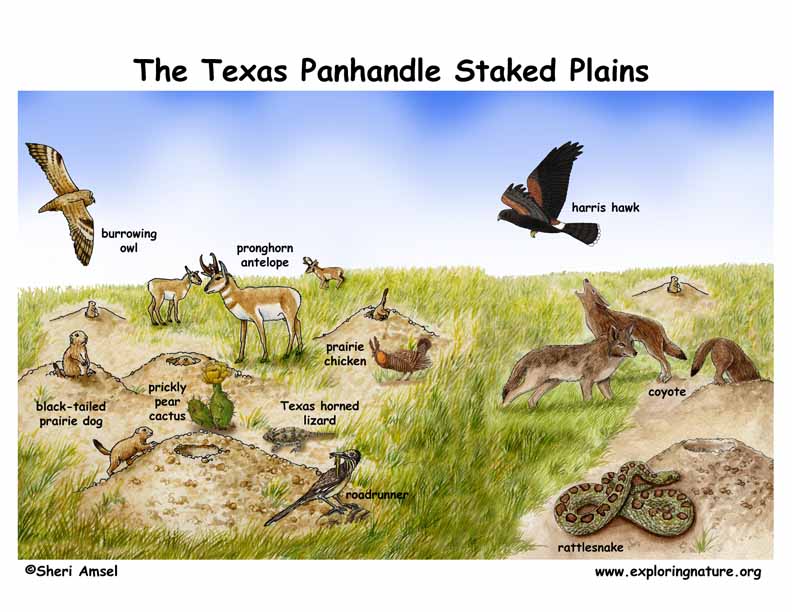

Texas is a large state made up of many diverse habitats. The west Texas panhandle is made up of the high, arid Trans Pecos and Staked Plains.
The Trans Pecos and Staked plains are covered by shortgrass prairie and scrub oak shinnery – a dense growth of small trees. This dry grassland rises into one of the largest tabletop mesas in North America.
Though dry, the region is home to many species of animals. The pronghorn antelope is considered the fastest animal in the western hemisphere reaching speeds of 60 mph. The black-tailed prairie dog lives out on the dry grassland in colonies called “towns” made up of vast underground tunnels that can have hundreds of prairie dogs. Each town has smaller groupings called neighborhoods (or coteries). They are an important keystone species providing food and shelter for other animals in their habitat. One predator that hunts prairie dogs and other animals is the coyote. Though considered a scavenger, the adaptable coyote will hunt small animals and sometimes even take deer. They also eat already dead animals (carrion), plants, fruits and whatever else they can find. The Texas horned lizard is covered with scales, some of which point outward forming protective spines all over the body. They have a rounded body and face when seen from above (though are flattened from the side), which has earned this lizard the nickname "horny toad." Though they look dangerous, they are not poisonous, but have a protective skill of squirting blood out of a tiny opening around the eye when threatened. The prairie rattlesnake, on the other hand, does have a venomous bite and blends into the landscape while warming in the sun. They are one of the species that uses the prairie dog tunnels for shelter. In the spring, male lesser prairie chickens stand on small rises and display to attract mates. They puff up their orange cheek patches and stamp their feet and dance. This is called "booming." The roadrunner can run along the ground at more than 15 mph and is an efficient predator, beating larger prey to death against rocks. Other birds found here are the burrowing owl, ferruginous hawk, Harris hawk, and curlew.
This semi-desert grassland is covered in short to midgrass prairie and low shrubs, like: creosote, acacia, mesquite, and cacti. There are also small trees, like scrub oak and pinyon-juniper.
When you research information you must cite the reference. Citing for websites is different from citing from books, magazines and periodicals. The style of citing shown here is from the MLA Style Citations (Modern Language Association).
When citing a WEBSITE the general format is as follows.
Author Last Name, First Name(s). "Title: Subtitle of Part of Web Page, if appropriate." Title: Subtitle: Section of Page if appropriate. Sponsoring/Publishing Agency, If Given. Additional significant descriptive information. Date of Electronic Publication or other Date, such as Last Updated. Day Month Year of access < URL >.
Amsel, Sheri. "Pecos and Staked Plains of the Texas Panhandle" Exploring Nature Educational Resource ©2005-2024. December 13, 2024
< http://www.exploringnature.org/db/view/Pecos-and-Staked-Plains-of-the-Texas-Panhandle >

